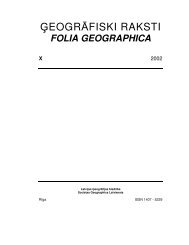eogrÄfiski raksti folia geographica xii - Ä¢eogrÄfijas un Zemes zinÄtņu ...
eogrÄfiski raksti folia geographica xii - Ä¢eogrÄfijas un Zemes zinÄtņu ...
eogrÄfiski raksti folia geographica xii - Ä¢eogrÄfijas un Zemes zinÄtņu ...
Create successful ePaper yourself
Turn your PDF publications into a flip-book with our unique Google optimized e-Paper software.
69<br />
HUMAN GEOGRAPHY<br />
After economic declines and a short period of inertia in the rural areas, a migration<br />
reversal started. Internal migration flow data show that movement between cities and rural areas<br />
represent about 30% (Table 3) of domestic migration. Between 1993 and 2000 rural areas saw<br />
population increases as a result of migration, mostly from the city of Riga. Migration had led to<br />
more arrivals than departures in rural areas, although the positive internal migration balance<br />
could not compensate for the population decreases that had occurred as the result of natural<br />
movement. More people, however, moved from the rural areas to the major cities and local<br />
centres during this period than was the case in the opposite direction (Table 4).<br />
Analysis of the flow of migration among populated areas that are on different levels of<br />
the urban hierarchy (the capital city, major cities, district centres, local centres, rural areas)<br />
show that they have different migration balances. Since 1993, Riga has lost 17,188 people<br />
(2.3% of the population in 2002) as the result of internal migration. In 2000 Riga had a negative<br />
migration balance in relation to all of the populated areas that are lower on the hierarchy scale,<br />
save only for district centres. [Krišjāne, Bauls 2002]<br />
Table 4<br />
The internal migration balance among settlements on various levels of the hierarchy,<br />
1993-2000*<br />
Total Riga<br />
Other<br />
major<br />
cities<br />
District<br />
centre<br />
Local<br />
centre<br />
Rural areas<br />
Riga -12195 0 2088 -1683 3441 8349<br />
Other major cities 7084 -2088 0 -1446 -598 -2952<br />
District centre -3498 1683 1446 0 -277 646<br />
Local centre 2908 -3441 598 277 0 -342<br />
Rural areas 5701 -8349 2952 -646 342 0<br />
* Calculated according [LR CSP/CSBL - Central Statistical Bureau of Latvia]<br />
For major cities other than the capital city, the migration balance between 1993 and 2000<br />
was positive in total numbers and in relation to other kinds of populated areas. District centres<br />
saw a negative migration balance in relation to all other kinds of populated areas except small<br />
towns.<br />
Analysis of the flow of migration in cities allows us to conclude that Riga often absorbs<br />
people from district centres. One of the main motivations to change the place of residence is the<br />
ability to find a better job in the capital city. This means that district centres lose fairly well<br />
qualified professionals. Major cities outside the capital city attract labour from the surro<strong>un</strong>ding<br />
territory and from other cities. It is possible that older people may be moving from Riga to the<br />
small towns, while yo<strong>un</strong>g people are moving to bigger cities in pursuit of an education. Each<br />
year approximately one-half of the yo<strong>un</strong>g people of Latvia, for whom the dominant motivation<br />
in life is education, are concentrated in Riga.<br />
To be sure, a well-paid job and job opport<strong>un</strong>ities are one of the key factors in internal<br />
migration processes too. That is certainly the case of Latvia, where there are distinct regional<br />
differences in terms of employment and income. This is particularly true when one compares<br />
the capital city of Riga and its metropolitan area on the one hand and the more peripheral<br />
regions of the co<strong>un</strong>try on the other. Inevitably, there is increasing movement of people from<br />
rural regions to cities or their metropolitan areas. The comparative poverty, the <strong>un</strong>acceptably<br />
low level of social contacts in rural areas, those are among the factors which cause people to<br />
leave the rural areas and move to the city. That is particularly true among people who are of<br />
working age.<br />
Between 1990 and 1996 the Riga agglomeration did not see an increase in population as<br />
the result of internal migration, because more people left the metropolitan region for other parts<br />
of Latvia than arrive from other areas. Beginning in 1997, however, the migration balance<br />
became positive again, especially in areas that are near the city.<br />
Since 1990 Riga itself has lost residents each year due to internal migration. The most<br />
intensive flow of migration has been between Riga and the city’s greater metropolitan area. If

















